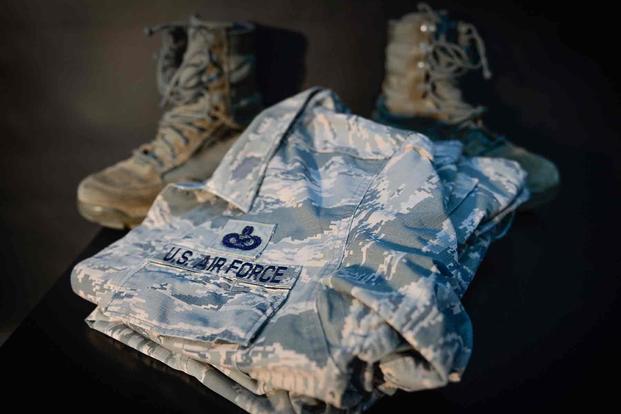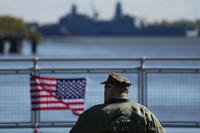Department of the Air Force officials unveiled changes to the service's uniform rules but nothing regarding beards, one of the rank and file's most requested -- but controversial -- policy changes.
The new regulations, unveiled in a press release Tuesday, change a variety of rules ranging from saluting decorum and patches on certain uniforms to allowing different colors for backpacks and new clothing options for when it's cold outside.
Air Force Chief of Staff Gen. Charles "C.Q." Brown approved the changes to the uniform policy; they're set to be enacted April 1.
Read Next: Air Force Fires Guam Commander for 'Shortfalls in His Personal Conduct'
According to the press release, the changes:
- Authorize installation commanders to designate Child Development Centers as a "no-hat, no-salute zone" in which salutes are not required when either person is carrying children.
- Allow service members to wear a cold-weather headband in addition to existing cold weather accessories, which include scarves, earmuffs, watch caps and gloves.
- Grant a total of four badges on the Operational Camouflage Pattern (OCP) uniform above the Air Force tape, up from the currently authorized two badges.
- Add an Operational Camouflage Pattern patrol cap or tactical cap while in the Flight Duty Uniform (FDU).
- Allow a "small logo" on purses and handbags not exceeding one inch in diameter.
- Add olive drab green as an authorized backpack color -- in addition to the already permitted black, brown, gray and dark blue colors -- to wear with any uniform combination.
- Allow a logo of any size on gym bags.
- Expand the current regulation to allow cold-weather parkas to be commercially purchased, with certain exceptions. Parkas must be OCP pattern or Coyote Brown and have name tapes, service tape, rank and patches worn in the same authorized configuration.
- Allow for Friday morale shirts with larger logos up to five inches in diameter, but the shirts must be Coyote Brown.
- Authorize the wear of "heritage-like" morale patches on the Flight Duty Uniform.
While the Uniform Board modified a few long-standing rules, it did not address beards for the rank and file.
The same day the regulations were made public, Chief Master Sgt. JoAnne S. Bass, the senior enlisted leader of the Air Force, released a memo on Facebook and called on commanders to get rid of the stigma for those with shaving waivers.
"Teammates -- it is up to all of us … leaders at all levels across the Total Force, to provide Airmen who are authorized to maintain facial hair -- either for medical or religious reasons, with the opportunity to thrive and advance their careers, without artificial barriers, stigmas or personal bias," Bass wrote on her Facebook page.
The memo is a much different message than one given by Air Force Chief Master Sgt. Ramon "CZ" Colon-Lopez, the senior enlisted adviser to the Joint Chiefs of Staff, who rebuked more progressive shaving policies on a Facebook livestream alongside Bass and Chief Master Sergeant of the Space Force Roger Towberman during the Air and Space Force Association's Warfare Symposium earlier this month.
"So, if you want to look cute with your skinny jeans and your beard, by all means do it someplace else. But quit wasting our time on something that doesn't have anything to do with kicking the enemy's ass," Colon-Lopez said at the time.
In recent months, the Department of the Air Force has amended many quality-of-life policies, including those for facial hair, amid a recruiting crisis and a recognition that some existing rules harm those of various religious beliefs, as well as certain minorities.
Military.com reported last August that the department is discussing a pilot program that would allow airmen and Guardians to grow beards.
And in December, Military.com reported that the Air Force Honor Guard, the outward-facing group of service members whose mission is to represent the ideal airman to the American public, has started allowing those with shaving waivers to sport beards.
Grooming standards requiring a clean shave can disproportionately affect minority service members. Some get frequent ingrown hairs and skin irritations known as pseudofolliculitis barbae, or PFB. The condition is often found in curly-haired men and occurs in about 60% of African American men, according to studies by the American Osteopathic College of Dermatology.
Black service members have also reported that obtaining a shaving waiver has harmed their careers.
A survey conducted for a 2021 study for the journal Military Medicine showed that, of those who had received shaving waivers, 21.4% said it had a negative impact on their careers. In all, 63% of those who said it harmed their careers or created negative bias within their unit were Black.
Bass wrote in her memo that the Air Force is still looking into how to better accommodate facial hair in the service.
"With each change we make to expand opportunity to serve and reduce artificial barriers, I am keenly aware the authorization of beards across the Total Force is at the forefront for many," Bass wrote. "I am writing you to make it clear that as we continue to look at this and other issues, we can and must act now to remove any stigma, or personal bias, toward those Airmen authorized to maintain facial hair, either for medical or religious reasons."
-- Thomas Novelly can be reached at thomas.novelly@military.com. Follow him on Twitter @TomNovelly.
Related: Beards in the Military Don't Help with 'Kicking the Enemy's Ass,' Top Enlisted Adviser Says













